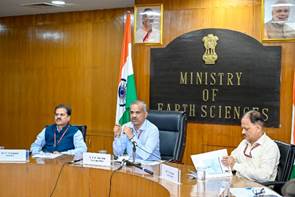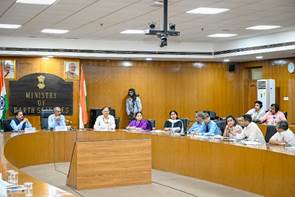Mission Mausam Unveiled: A 2,000 Crore initiative to Enhance India’s Weather and Climate Forecasting by 2026
The Ministry of Earth Sciences (MoES) organised a national-level press inetarction on Mission Mausam at Prithvi Bhavan in New Delhi.
Dr M Ravichandran, Secretary, MoES, addressed the media along with Dr. Mritunjay Mohapatra, Director General of India Meteorological Department (IMD), and the Head of National Centre for Medium-Range Weather Forecasting (NCMRWF), Dr VS Prasad.
The Union Cabinet approved Mission Mausam on September 11, 2024, with a budget outlay of 2,000 crores over two years, is an ambitious initiative of the Government of India. It aims to make India ‘Weather Ready’ and ‘Climate Smart’. The mission seeks to exponentially enhance the country’s weather and climate observations, understanding, modelling and forecasting, leading to better, more useful, accurate and timely services.


Dr M Ravichandran, Secretary, MoES (centre) with DG, IMD (left) and Head, NCMRWF (right), addressing the media and glimpse of the press briefing session on Mission Mausam at MoES Headquarters, New Delhi.
Mission Mausam has the goal of making Bharat a "Weather-ready and Climate-smart" nation, so as to mitigate the impact of climate change and extreme weather events and strengthen the resilience of the communities. Currently the Mission Mausam will be implemented during 2024-26.
The objectives of the proposed “Mission Mausam” includes:
- Develop Cutting Edge Weather Surveillance Technologies & Systems
- Implement Higher resolution atmospheric observations with better temporal and spatial sampling/coverage
- Implement Next-generation radars, and satellites with advanced instrument payloads
- Implement High-Performance Computers (HPC).
•Improve understanding of weather and climate processes and prediction capabilities
•Develop improved earth system models, and data-driven methods (use of AI/ML)
•Develop Technologies for weather management
•Develop state-of-art dissemination system for last mile connectivity
•Capacity building
The mission aims to establish 50 Doppler Weather Radars (DWR), 60 Radio Sonde/Radio Wind (RS/RW) stations, 100 disdrometers, 10 Wind Profilers, 25 radiometers, 1 Urban testbed, 1 Process testbed, 1 Ocean Research station and 10 Marine Automatic Weather Stations with upper air observation.
According to secretary MoES, Mission Mausam will improve forecasts on both spatial and temporal scales and air quality data and help strategize weather management/intervention in the long run. “By March 2026, we are looking at installing a wider network of radars, wind profilers, and radiometers for better observations. We also look forward to better understanding the physical processes and the science of weather forecasting. There will be improved data assimilation with increased ingestion of the observations. We will also fuse physics-based numerical models and data-driven AI/ML to improve the forecasts. We would witness more innovations, R&D and advancements in atmospheric sciences”, said Dr Ravichandran.
Dissemination of data and services and capacity-building will also be expanded to benefit citizens and stakeholders. No weather system in the country will go undetected. MoES will provide improved services for weather, climate, and natural hazards, thereby ensuring the transfer of commensurate economic and social benefits to the various sectors, he added.
Three institutes of the MoES: IMD, NCMRWF and the Indian Institute of Tropical Meteorology, will primarily implement Mission Mausam. These institutions will be supported by other MoES institutions (Indian National Centre for Ocean Information Services and National Institute of Ocean Technology) along with collaborating national and international institutes, academia and industries, furthering India's leadership in weather and climate sciences and services.
*****
KSY/PSM/AG